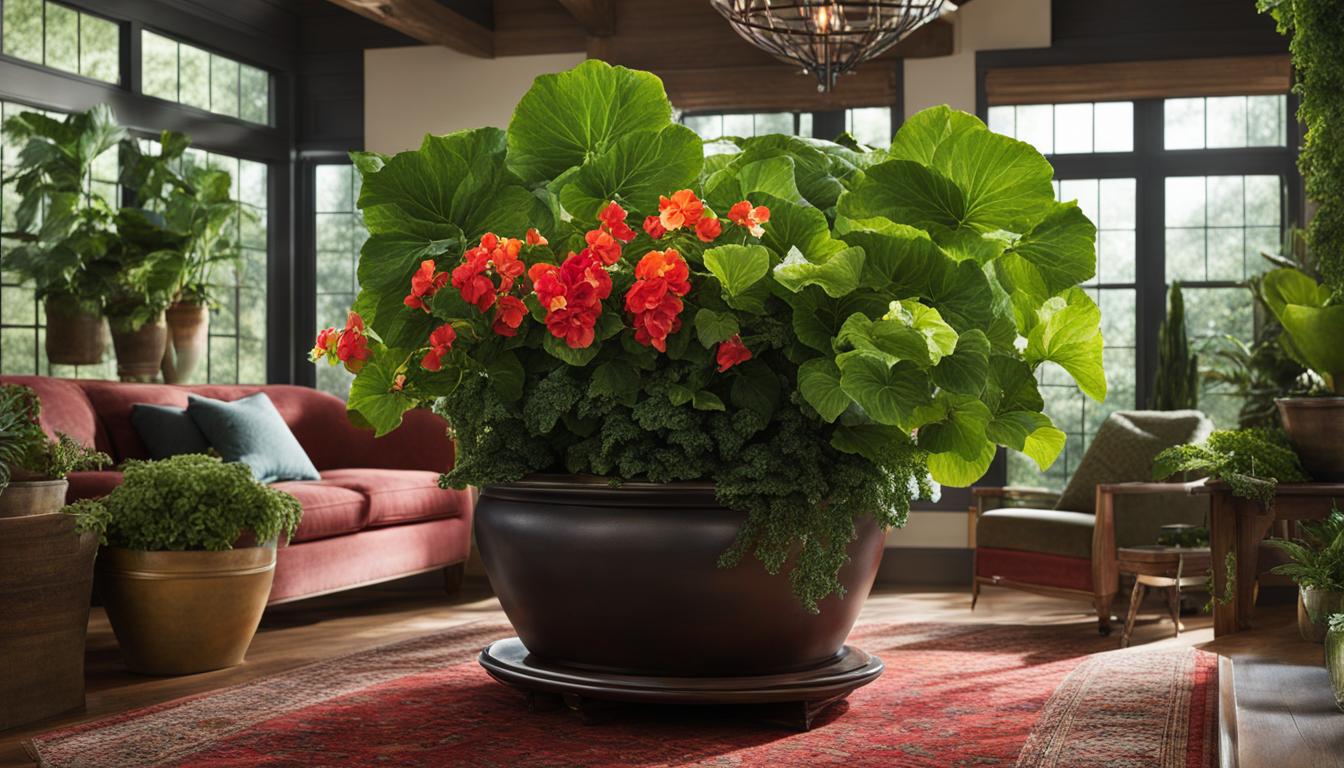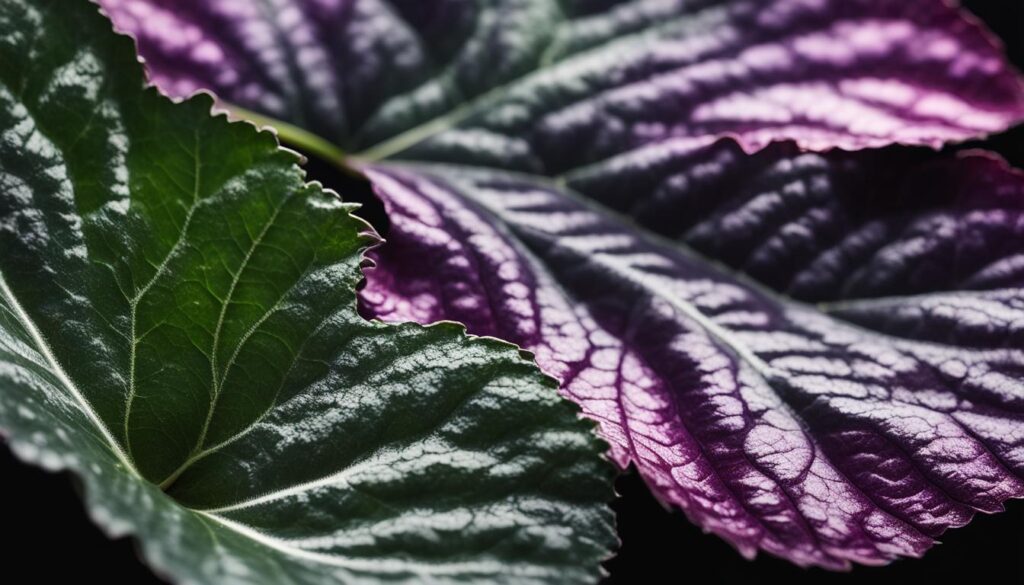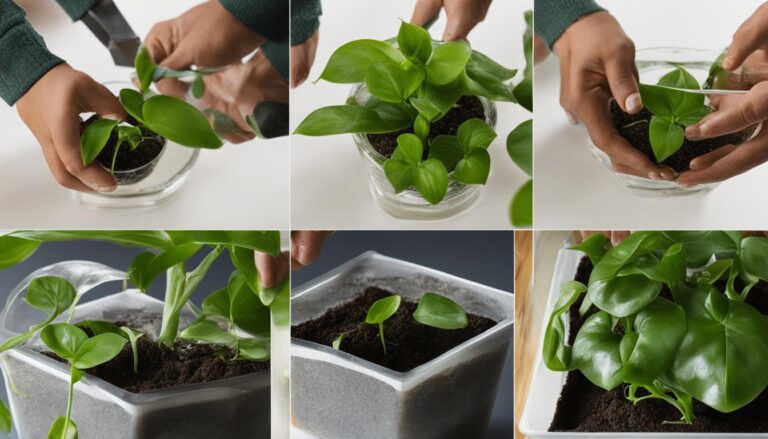
Welcome to my comprehensive guide on mastering the growth of Rex Begonia (Begonia rex-cultorum) in your home. As a popular houseplant, these stunning indoor plants are beloved for their large variegated leaves in shades of green, red, silver, and purple.
In this article, I will cover everything you need to know about caring for this unique plant species, including the specific conditions it requires to thrive.
Rex Begonia, also known as painted-leaf begonia or fancy-leaf begonia, offers a touch of tropical beauty to any indoor space. However, it’s essential to understand the care requirements to bring out the best leaf color and keep your Rex Begonia healthy.
Continue reading to discover the care requirements, popular varieties, propagation methods, and common problems faced by Rex Begonia enthusiasts. Whether you are a seasoned plant parent or just beginning your indoor gardening journey, this guide will provide you with valuable insights to master the art of growing Rex Begonia in your home.
Understanding the Care Requirements of Rex Begonia
Rex begonias, also known as Begonia rex-cultorum, are beautiful and unique plants that require specific care to thrive. By understanding their care requirements, you can ensure that your rex begonias grow healthy and vibrant. Here are the main aspects of care to keep in mind:
Lighting
Rex begonias prefer bright indirect sunlight, so it’s important to place them in a location where they receive filtered light. Direct sunlight can scorch the leaves, so it’s best to avoid it. If you have limited natural light in your home, you can also use artificial grow lights to provide the necessary light for your rex begonias.
Watering
Proper watering is essential for rex begonias. They thrive in well-draining soil, so make sure to use a potting mix that allows excess water to flow out. Water your plants regularly, allowing the top inch of soil to dry out before watering again. Overwatering can lead to root rot, so be mindful not to let the soil become waterlogged.
Temperature and Humidity
Rex begonias prefer temperatures between 65-75°F (18-24°C) during the day and slightly cooler temperatures at night. They also thrive in moderate humidity levels of around 50-60%. To create a humid environment, you can place a tray of water near your begonias or use a humidifier. Additionally, avoid placing your rex begonias near drafts or temperature extremes, as they are sensitive to temperature fluctuations.
Soil Type
Using the right soil is crucial for the growth of rex begonias. They prefer a light and airy soil mix, similar to the one used for African Violets. This type of soil provides adequate drainage while retaining some moisture. You can also add perlite or vermiculite to improve the soil’s texture and drainage properties.
By following these care requirements, you can ensure that your rex begonias thrive and add a touch of unique beauty to your indoor garden.
Explore Popular Varieties and Propagation Methods for Rex Begonia
Rex begonias are highly sought after for their stunning variety of colors and patterns. With their large, variegated leaves, they make a statement in any indoor garden. Let’s take a closer look at some popular varieties and the best methods for propagating these beautiful plants.
Varieties of Rex Begonia
Rex begonias come in a wide range of colors and leaf patterns. Here are a few popular varieties you might consider adding to your collection:
| Variety | Description |
|---|---|
| Rex Begonia | Green and burgundy leaves with silver veins |
| Fragrant Begonia | White and pink flowers with a delightful fragrance |
| Tuberous Begonia | Large double blooms in vibrant shades |
These are just a few examples, and there are many more unique rex begonia varieties to explore and appreciate.
Propagation Methods
If you want to expand your collection of rex begonias or share these stunning plants with friends, propagation is a great option. Here are three effective methods for propagating rex begonias:
- Rhizome Division: Divide the rhizomes in spring when the plant is actively growing. Carefully separate the rhizomes and plant them in separate pots.
- Layering: Pin a stem to moist bedding mix and wait for it to develop roots. Once rooted, you can separate the new plant from the parent.
- Leaf Cuttings: Take a healthy leaf and cut it into sections. Place the leaf sections in a moist soil mix, and over time, they will develop into new plants.
By using these propagation methods, you can easily create new rex begonias and continue to enjoy their beauty throughout your home.

As you can see, rex begonias offer a wide variety of colors and patterns, making them a popular choice among plant enthusiasts. With the right propagation methods, you can expand your collection and share the beauty of these plants with others.
Addressing Common Problems and Solutions for Rex Begonia
When it comes to growing rex begonias, there are some common problems that can arise. Fortunately, with a little knowledge and proactive care, these issues can be easily addressed. One of the most common problems is leaf loss or rot.
This typically occurs due to overwatering, which leads to root rot. To prevent this, make sure to water your rex begonia only when the top inch of soil is dry to the touch. Additionally, be sure to use a well-draining potting mix to avoid waterlogged roots.
Wilting or curling leaves can also be a cause for concern. This is often a sign of environmental issues such as improper lighting, low humidity, or inconsistent watering. Rex begonias thrive in bright indirect sunlight, so make sure to provide them with the right amount of light.
Maintaining a humidity level of around 50-60% can also help keep their leaves healthy. Lastly, make sure to water your rex begonia consistently, avoiding both overwatering and underwatering.
Another problem that rex begonias may encounter is overly soft leaves. This can indicate inadequate watering, where the plant is not receiving enough moisture.
To remedy this, make sure to water your begonia thoroughly, allowing excess water to drain away. However, be careful not to let the plant sit in standing water, as this can also lead to root rot.
In addition to these common problems, rex begonias can be susceptible to pests and diseases. Mealybugs are one common pest that can infest rex begonias, sucking sap from the leaves and causing damage.
To combat mealybugs, regularly inspect your plants and remove any affected leaves or pests. Powdery mildew is another issue that can affect rex begonias, causing a white powdery coating on the leaves. To prevent powdery mildew, make sure to provide proper air circulation around your plants and avoid overcrowding.
FAQ
Are rex begonias easy to care for?
Rex begonias are considered one of the easier houseplants to care for. They adapt well to many conditions and will indicate if they are unhappy with their water, light, or soil conditions.
How fast do rex begonias grow?
Rex begonias grow at a medium rate. They prefer a pot with room to grow, which means you won’t need to repot them too frequently.
How long can rex begonias live?
A well-cared-for rex begonia plant can thrive for a few years. However, they propagate easily, allowing gardeners to continually renew their collection with new plants from cuttings.
What are the ideal light conditions for rex begonias?
Rex begonias prefer bright, indirect light year-round. They can tolerate less light than other begonias and will even thrive under fluorescent lights.
What type of soil is best for rex begonias?
An airy, light, fast-draining soil is best for rex begonias. They thrive in well-aerated peat-based potting soil within containers.
How should I water rex begonias?
Rex begonias require regular watering but should not be overwatered. The soil should be slightly moist and allowed to dry to the touch before watering again. They enjoy humidity but do not like their foliage to remain wet, as this can encourage powdery mildew.
FAQ
What are some care requirements for growing rex begonias?
Rex begonias require a porous potting mix in a shallow pot, regular watering with the top inch of soil allowed to dry out between waterings, bright indirect sunlight, a temperature range of 65-75°F, and a humidity level of around 50-60%.
How can I propagate rex begonias?
Rex begonias can be easily propagated through rhizome division, layering, or leaf cuttings. Dividing the rhizomes in spring, pinning stems to bedding mix, or using leaf cuttings are all effective methods for propagating new plants.
What are some popular varieties of rex begonias?
Some popular varieties of rex begonias include Rex Begonia (green/burgundy leaves with silver veins), Fragrant Begonia (white/pink flowers with a delightful fragrance), and Tuberous Begonia (large double blooms in vibrant shades).
What are some common problems for rex begonias?
Common problems for rex begonias include leaf loss or rot, wilting or curling leaves, and overly soft leaves. These issues can be caused by overwatering, improper lighting or humidity levels, and inadequate watering. Rex begonias can also be prone to pests such as mealybugs and powdery mildew.






